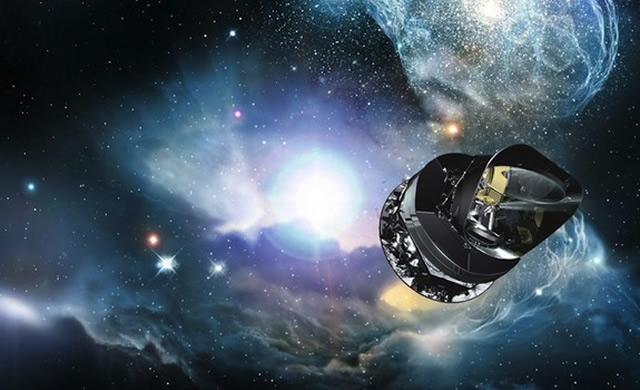
Planck – Credit: ESA
Un articolo pubblicato su Monthly Notices, analizzando l’equazione di stato dell’energia oscura, suggerisce che la sua vera natura sia una forma dinamica dell’energia del vuoto quantistico, variabile nel tempo. Compatibile con i risultati di BICEP-2? Media INAF lo ha chiesto ai due autori.
Partiamo dalle conclusioni. Cos’hanno dedotto i due autori, Spyros Basilakos e Joan Solà (dall’università di Atene il primo e da quella di Barcellona il secondo), analizzando l’equazione di stato dell’energia oscure a fronte dei dati raccolti dalle missioni spaziali WMAP e Planck? «L’energia oscura, secondo noi, non è né quintessenza né energia fantasma. Ciò che diciamo, nel nostro articolo, è che siamo di fronte a una sorta di miraggio: ha le sembianze della quintessenza, o dell’energia fantasma, ma in realtà», dice Joan Solà a Media INAF, «è energia del vuoto dinamica. Dinamica nel senso che varia nel tempo, a differenza di quanto ipotizzato dal vecchio modello della costante cosmologica». La quintessenza alla quale si riferiscono i due cosmologi è una forza di gravità al contrario: invece di attrarre respinge. Dunque una forza fondamentale – sarebbe la quinta, nomen omen – che sembrerebbe cascare a proposito per spiegare l’espansione accelerata del nostro universo. E di conseguenza la natura dell’energia oscura, comunemente additata come responsabile di quest’accelerazione.
«Stiamo per pubblicare un articolo nel quale mettiamo a confronto il nostro modello con i dati di BICEP-2, ma posso già dire che otteniamo un valore di r compatibile, entro un sigma, con quello da loro misurato», anticipa Basilakos a Media INAF, riferendosi a quell’oramai mitico tensor-to-scalar ratio che misura l’ampiezza delle onde gravitazionali primordiali.
Fonte/Leggi tutto → Media.INAF.it
Cosmologists believe that some three quarters of the universe are made up of a mysterious dark energy which would explain its accelerated expansion . The truth is that they do not know what it could be, therefore they put forward possible solutions. One is the existence of quintessence, an invisible gravitating agent that instead of attracting, repels and accelerates the expansion of the cosmos.
From the Classical World until the Middle Ages, this term has referred to the ether or fifth element of nature, together with earth, fire, water and air. Another possibility is the presence of an energy or phantom field whose density increases with time, causing an exponential cosmic acceleration. This would reach such speed that it could break the nuclear forces in the atoms and end the universe in some 20,000 million years, in what is called the Big Rip. Now researchers from Barcelona and Athens suggest that both possibilities are only a mirage in the observations and it is the quantum vacuum which could be behind this energy that moves our universe. The experimental data that underlie these two hypotheses comes from satellites such as Planck of the European Space Agency (ESA) and Wilkinson Microwave Anisotropy Probe (WMAP) of NASA. Observations from the two probes are essential for solving the so-called equation of the state of dark energy, a characterising mathematical formula, the same as that possessed by solid, liquid and gaseous states.
Now researchers from the University of Barcelona (Spain) and the Academy of Athens (Greece) have used the same satellite data to demonstrate that the behaviour of dark energy does not need to resort to either quintessence or phantom energy in order to be explained. The details have been published in the Monthly Notices of the Royal Astronomical Society journal.
Source/Continue reading → www.dailygalaxy.com





















